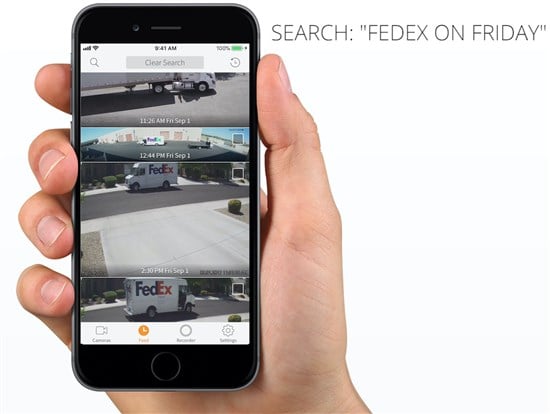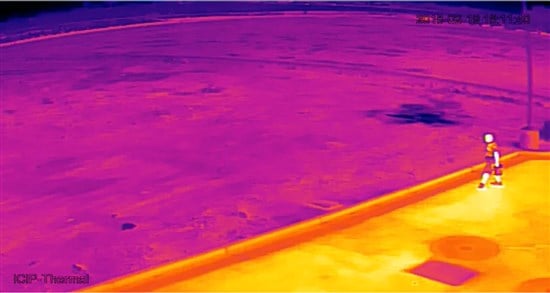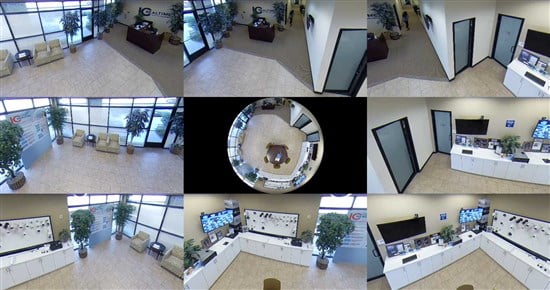When looking for a surveillance camera system, it is easy to get overwhelmed by the huge number of products available and the confusing technical jargon that comes with them. Just walk into any big box retailer and there are numerous brands all seemingly selling the exact same camera. Every brand claims to offer high resolution and night vision, and sorting through the claims can be confusing.
What many people do not realize is that there is another class of security camera that is directly available to the public, though not found in the big box and warehouse stores. These surveillance cameras are classified as "commercial-grade" security cameras and are the type of camera used by these big box chains to secure their inventory. Look at the ceiling of consumer electronics stores and warehouse chains and you will notice in each aisle a white dome camera that is larger than the average consumer camera. Let that sink in for a moment…these companies do not even use the type of cameras they are selling to the public, and there is a good reason why.

Commercial-Grade vs. Consumer-Grade Security Cameras
As you just learned, there are two broad categories of security cameras. What you generally find at stores are consumer-grade cameras, which usually come 8 or 16 cameras bundled with a video recorder and sell for less than a thousand dollars (US $) for the set. The second category of camera, commercial-grade cameras, generally starts at about $400 (US) per camera— a significantly higher price. The video recorder must be purchased separately, and commercial grade recorders start at about $500 (US $) and can range up to $5000 depending on the amount of storage, camera connectivity, and image processing features.
Quality
On the surface, these two camera categories may appear similar, though if you were able to see inside, the differences become obvious and distinct. Commercial-grade cameras are designed and built for high-performance applications where failure is not an option; consumer-grade cameras are not. Typically, consumer-grade cameras are built to work well when there is plenty of available light, and once the lighting becomes low or absent (think sunset or nighttime), their pedigree begins to show. Commercial cameras outperform their cheaper cousins because they have larger internal video sensors and higher-quality components that can adapt and capture excellent low light video.
Think of it this way, if a decent still-camera costs a minimum of two hundred and fifty dollars (US $), how can a more sophisticated video camera be sold for the low price of forty dollars? It just does not add up. To offer such low prices, manufacturers must cut corners, and the end result is compromised performance. What good is a surveillance camera that only works ideally in perfect conditions like bright sunlight? Consumer-grade cameras can work well in certain situations such as nanny cams or checking in on a pet, though when looking to gather evidence of a crime they often come up short.
The rest of this article will focus on commercial-grade surveillance cameras, as you will learn they are the best choice to monitor your valuables and catch the bad guys.
 Mixed Lighting Conditions
Mixed Lighting Conditions
Commercial-grade surveillance cameras prove their superiority when dealing with difficult lighting conditions. For example, it is common for a business to have a camera pointed at the front door of their store. When someone opens the door, a large amount of sunlight will shine through the doorway, flooding the camera’s sensor. A consumer-grade camera will try to adapt to the extra light being let in the room and will open its shutter to compensate. In turn, this causes the doorway to look properly exposed, though the store itself now appears dark because the room in which the camera is mounted is darker than the area of the doorway. In this case, the business owner ends up having a well-exposed doorway, though an indoor image that is too dark to be usable. Meanwhile, the face of the person walking into the store is never captured because they are standing in the under-exposed store. Though the example given here is for a store, homes often have challenging mixed lighting conditions, too.
Commercial-grade cameras solve this problem with a special light-handling feature. These cameras use both a software and hardware solution called HDR, which stand for “High Dynamic Range”. In our example here, HDR takes an exposure of the room and an exposure of the doorway and then combines the two images together to create a properly-exposed composite image of the two areas. As far as anyone is concerned, the image looks completely normal since the doorway and room appear to be at the same brightness level. As a result, faces are properly exposed at the door and in the store, accomplishing the goal of capturing video of everyone entering the store. HDR is now a standard feature in commercial cameras. Unfortunately, once customers realize that the inexpensive consumer camera they bought is lacking HDR, it’s usually too late since the cameras and recorders are installed.
Night Vision
Now let’s examine why consumer-grade cameras are often poor night vision performers. When a camera tries to see in the dark, it needs a light source to illuminate the area below it. Unfortunately, the night vision illuminators that come with consumer cameras are designed for short range only and are of a fixed brightness. This means they typically over-expose what is nearby in a scene, causing people and objects to appear “blown out” and without any detail. So much for trying to identify the bad guys. Commercial cameras, however, often are equipped with more advanced night vision infrared (IR) illuminators that can adjust their brightness automatically to the scene. This feature is called “Smart IR”, and it matches the camera’s infrared light output to the scene. With Smart IR, the subjects appear properly exposed and in full detail. If a camera cannot capture and deliver a properly-exposed and sharp image during the day and at night, it has limited usefulness.
How Much Camera Resolution is Enough?
Another important topic to discuss is camera resolution. It can be confusing to understand how much is enough. In this article, the term “resolution” refers to the number of dots (pixels) that make up a video picture; the more dots, the more detailed the video image. The same is true of high-resolution TV sets, and the two most popular TV resolutions today are 1080p and 4K. 4K resolution contains about four times as much picture information as 1080p. Surveillance cameras are also manufactured in these two resolutions, and it would be natural to believe that the more dots in your video image the better, right? Yes and no. When it comes to surveillance cameras, there are some tricky consequences to having such a high-resolution 4K image. In this case, more is not always better.
You would be hard-pressed to tell the difference between 1080p and 4K resolution when looking at a normal camera image. The one major benefit of 4K resolution is the ability to resolve detail after the fact, which means that users can zoom in on details such as faces while the recording of a security event plays. However, while 4K resolution offers some benefits, it also brings with it some drawbacks. 4K images are very large and take up a lot of recording storage space. So much, in fact, that they need about four times the hard drive space of 1080p to record the same length of video footage. Be prepared to spend more money if extended video storage is important.
If you are interested in a 4K camera system, you ideally will have a very high-speed Internet connection and a robust home network, ideally an enterprise-grade network. As discussed above, the 4K camera images are very large, and that is a lot of data to push around the home’s network and optionally, to an offsite cloud recording service (more on that below). Rely on your HTA Certified technology professional for advice here, as they will be able to determine if a 4K camera system will work in your situation. Some of the better camera system brands have controls to adjust some of the recording parameters in order for slower network connections to still work reliably. Keep in mind that 1080p resolution generally has enough detail to deliver important video information while preserving network bandwidth and hard drive storage.
 Integration…Does the Camera System Play Well With Others?
Integration…Does the Camera System Play Well With Others?
We have reviewed many important reasons why one should consider commercial-grade cameras so far, however, we have just skimmed the surface of the subject. In today’s network-connected world, a surveillance system is rarely a stand-alone system. It is worth knowing if your proposed camera system will integrate with other products.
Integration refers to “smart” devices that can talk to one another via a network. With the advent of the connected home (aka “smart home”) and products that give you the ability to control lighting, audio/video, door locks, alarm systems and more, commercial camera systems can often communicate with other smart devices, such as voice control products. For example, a voice-controlled product like the Amazon Echo can display a camera view just by asking for it. Another example of the benefit of integration is when a security sensor is triggered due to an intrusion. First, the alarm is set off, but then the lights throughout a house can be automatically turned on, and perimeter doors can lock tight, trapping the burglar. Systems that once had little to do with one another can now act in concert creating new features and benefits.
Remote Video Storage…a Growing Trend
With an Internet connection comes another game-changer that transforms how video is accessed and stored. This relatively new trend is referred to as cloud video storage, and what makes it so amazing is that now all video from your cameras can be uploaded to remote storage. Why does this matter? In the past, if bad guys broke into a home and took the family jewels there was always a risk that they could steal the security video recorder too, which would be a real tragedy. No jewels and no video for the police to catch them. Though with cloud video storage this doesn’t ever have to happen again. When the bad guys break in and look for the recorder, this time there just might not be one to steal. Each camera can send its video directly to the cloud via the Internet, and once that video is uploaded to the cloud it is safe forever—which can mean a much bigger chance of catching the thieves and recovering the jewels. Cloud video storage has become a ubiquitous part of the security landscape with more security video users opting for cloud backup in addition to the on-site recorder or forgoing the local recorder altogether. Networking is having a major effect on how video security customers are storing their video and the trend towards the cloud will continue to grow.
Hacking…and Tips to Prevent It
It is impossible to deny the huge benefit customers gain by attaching their security cameras to the Internet, though as is frequently mentioned by the media, there are hackers lurking everywhere. It has become a fact of Internet life that no computer is 100% safe, and regrettably, security camera systems are at risk as well. The surveillance camera industry has been plagued over the last few years by various hacks and exploits being discovered by security researchers and hackers alike. Very few security manufacturers have been spared the embarrassment of finding out that their recorders and cameras have been hacked and controlled by some unauthorized person.
As a result, there is a renewed interest in making sure that security systems are protected from network threats. One of the best ways to protect your surveillance camera system is by using what is called a VPN Router/Firewall which is a type of computer designed to keep out unwanted threats. These devices are becoming the defacto standard when protecting any kind of networked equipment. Other technologies that were originally designed to make networking easier like P2P, and Port Forwarding, have only increased the ways that hackers can penetrate your network. Network security has become a necessary part of setting up and installing a security camera system and is one area that no one can afford to ignore. HTA Certified installation pros that install camera systems (noted in their company profiles) will be able to recommend and implement security best practices.
Deep Learning Search…Search Your Video Footage Nearly Instantly
There is a new trend in surveillance video search technology that is quickly changing the security industry, and it is called “Deep Learning”. What is Deep Learning and why is it so important? For starters, Deep Learning allows someone to find what they are looking for without having to search through hours of useless video footage. Imagine a webpage that works a lot like a Google search, where you can describe the elements you are looking for in the recorded video footage. For example, if we need to see all video from today that has a police car in it, we simply type “police” into the search window and in seconds every key frame of video with a police cruiser appears. It simply is magical compared to the way video once was searched by tediously scanning through hours of recording footage. If we are looking for any FedEx trucks that came by the house on Friday, we can instruct the deep learning search system to look for this and get a result like shown in the picture near the top of this page. With deep learning video search, you now have a powerful solution for catching criminals and collecting evidence.
 Thermal Cameras – Military Technology for Your Yard
Thermal Cameras – Military Technology for Your Yard
What is a thermal camera, and where might you want one? Here is a brief explanation of how thermal cameras work: All objects emit infrared energy (heat) as a function of their temperature. The infrared energy emitted by an object is known as its heat signature. In general, the hotter an object is, the more radiation it emits. A thermal camera includes a heat sensor that is capable of detecting tiny differences in temperature. The device collects the infrared radiation from objects in the scene and creates an electronic image based on information about the temperature differences. Because objects are rarely precisely the same temperature as other objects around them, a thermal camera can detect them, and they will appear as distinct in a thermal image.
Thermal cameras are great for areas that have absolutely zero light and are also commonly used in areas of thick fog and or smoke. Though popular in commercial and government installations, they are now being used in high-end residential projects with large areas of ground to cover and/or little to no landscape lighting. Thermal cameras will allow you to see living objects via their heat signature from great distances that a normal camera could not.
360° & 720° Cameras – See the Big Picture
360° & 720° surveillance cameras use a specialized fish eye or spherical camera lens to offer a far wider viewing area compared to a normal/standard camera. 360° cameras can see in all directions, though in one hemisphere only. 720° cameras can see in all directions at the same time…up/down and left/right.
These cameras offer a wide field of view in one camera, though they often suffer from poor resolution when zoomed in. Although they cover a far larger viewing area, the resulting image often looks “warped” compared to the “flat” view a standard camera shows. The image then needs to be run through software in order de-warp or flatten the image to make it useable. Higher-end video recorders/processors can do this automatically via software to allow you to see the full-size image flattened rather than circular.
 Although 360° and 720° cameras may have the same resolution spec as that of a standard IP camera, that resolution is being spread over a much wider area and therefore offers fewer pixels per inch. Here is what this means, by way of an example. Assume two cameras, one a standard camera with a 130° field of view and the other a 720°camera, and both cameras are high-resolution 10MP (megapixel) models. This means the 720° camera has far less resolution per square inch; it is starting with the same image sensor, 10MP in this case, though it has to spread that image across a far larger space and therefore will not look as crisp of a camera that only has a 130° field of view.
Although 360° and 720° cameras may have the same resolution spec as that of a standard IP camera, that resolution is being spread over a much wider area and therefore offers fewer pixels per inch. Here is what this means, by way of an example. Assume two cameras, one a standard camera with a 130° field of view and the other a 720°camera, and both cameras are high-resolution 10MP (megapixel) models. This means the 720° camera has far less resolution per square inch; it is starting with the same image sensor, 10MP in this case, though it has to spread that image across a far larger space and therefore will not look as crisp of a camera that only has a 130° field of view.
Where are 360° and 720° cameras best used? In very large areas/rooms where the viewer needs a great overview of the whole scene rather than just a portion. When used in tandem with standard cameras for more pinpoint detail, these cameras are a great solution to overall situational surveillance.
Without a doubt, the security camera landscape is advancing rapidly. At the forefront of important technology meant to protect what is most important to you are intelligent search, perfected night vision, network integration, and possibly thermal imaging and 360° and 720° cameras. Cheap consumer-grade camera offerings do not deliver these new and important features. Yes, they may have the ability to view video over the Internet, but that is only valuable if the video footage is properly exposed and can compensate for differing and changing lighting conditions. Cheap cameras represent false savings and an expensive lesson if it fails to do its job when you need it most. In this article, we have discussed some of the reasons large companies use commercial-grade security cameras and why the benefits are worth the higher cost for your home and loved ones. If usable video is the goal, make sure the cameras have Smart Infrared, High Dynamic Range, and at least 1080p resolution. With a little bit of research, and most importantly, listening to your HTA Certified professional’s advice, a lot of heartache can be avoided later.
How to Hide Security Cameras
There are many ways you can hide security cameras. They can be disguised as or within other common household items, blended or camouflaged into the environment, or completely hidden using miniaturized pinhole or peephole cameras. Read more about this topic in this article: The Top 4 Ways to Hide Security Cameras.
Professional Installation
To help you choose the best surveillance camera system for your needs, seek out advice and installation from an HTA Certified company. HTA Certified technology integrators have demonstrated excellence in technical knowledge, customer service/aftercare, and reputation. Read more about the HTA Certification standard by clicking here. This website also includes a Budget Calculator that includes a surveillance camera budget range. You may access it here > Technology Budget Calculator. You may search for HTA Certified installation firms at this link > HTA Certified Integrators
 This article was authored by Matt Sailor, CEO & President of IC Realtime.
This article was authored by Matt Sailor, CEO & President of IC Realtime.
About IC Realtime:
IC Realtime designs and manufactures commercial-grade surveillance and security industry solutions. To learn more, visit www.icrealtime.com.







 Mixed Lighting Conditions
Mixed Lighting Conditions Integration…Does the Camera System Play Well With Others?
Integration…Does the Camera System Play Well With Others? Thermal Cameras – Military Technology for Your Yard
Thermal Cameras – Military Technology for Your Yard 


















